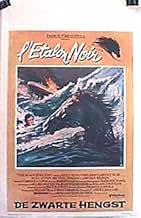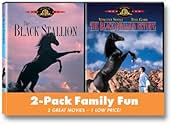PUNTUACIÓN EN IMDb
7,4/10
15 mil
TU PUNTUACIÓN
Un niño se encuentra con un caballo y forma un vínculo con él, y luego lo entrena para correr.Un niño se encuentra con un caballo y forma un vínculo con él, y luego lo entrena para correr.Un niño se encuentra con un caballo y forma un vínculo con él, y luego lo entrena para correr.
- Nominado para 2 premios Óscar
- 8 premios y 6 nominaciones en total
Larbi Doghmi
- Arab
- (as Dogmi Larbi)
John Karlsen
- Archeologist
- (as John Karlson)
Donald Hodson
- Taurog
- (as Don Hudson)
Argumento
¿Sabías que...?
- CuriosidadesAmong the innovations of sound editor Alan Splet, who won a special Oscar® for his work, was attaching microphones to the underside of the horse during the racing scenes to catch his actual hoof-beats and breathing.
- PifiasCyclone, the gray racehorse, changes from a soft pale gray, to a dappled gray, to a very dark gray with a white tail throughout the match race.
- Citas
Snoe: Hey, what happened to you?
Alec Ramsey: Everything.
Snoe: Everything? That's a whole lot. It can't be everything.
- Créditos adicionalesA scene played throughout the end credits showed Alec and the Black's time at the beach.
- Versiones alternativasThe 1994 VHS and 1997 DVD releases plaster the 1976 United Artists logo with the 1987 United Artists logo.
- ConexionesFeatured in Sneak Previews: Oscar Special 1980 (1980)
Reseña destacada
This film is offered as children's fare. That does not matter to me. It succeeds as an professionally presented film for adults.
I am in no position to bellyache about how little it resembles Walter Farley's children's book. I have read some of the book. The book does not interest me.
Neither does its set-up for whatever sequels interest me. They were, by most accounts, mediocre.
This film, "The Black Stallion", holds a great deal more for me than most other pictures.
The film is one of the most powerfully beautiful sets of moving images I have ever seen on screen conjoined with sumptuous music and gently mesmerizing performances. Its editing awards, cinematography awards, and the awards for its music all were well deserved.
From the wreckage of the "Drake" through the lengthy bonding of boy and horse on the island, through to their rescue, not a word is spoken. It is one of the longest, most intensely cast verbal negative spaces in film. Civilization is dispensed with, language is removed, layers of meaning are stripped; there is no intellectual comfort on which to fall back. Into that emptiness fall the sound of waves and wind and rain as though natural extensions of Carmine Coppola's exquisite score. The film's soundtrack is wonderfully uncomplicated and moving. The island sequences are visited by small groups of instruments in turn -- a harp here, primitive percussion there, minimal woodwinds; no brass intrudes for a long time -- in musical experiments of loneliness yielding to companionship that echo the tentative meetings of the boy and the horse.
Such negative spaces abound in "The Black Stallion", carved from the soundtrack (the roar and crush of sound in the midst of the final race sequence blur out into a blissful, quiet emptiness touched lightly by flute and brass), washed clean of visuals (for the bulk of one critical scene, horse and boy, the centers of attention, disappear, literally, and focus is on the tiniest details of ticking watch hands and empty sheets of translucent night rain), and opened at great lengths in the dialogue: Alec's mother responds to her son's plea with a tortured delay and Teri Garr, in remarkable performance, draws out her strangely active non-speech for many long seconds before her two-word reply closes this particular negative space with the thunderclap of a rushing locomotive and the thrust of a guitar as the soundtrack slams back in.
The final burst of joy from the island sequence's soundtrack is so magnificent, so full and compelling, it is odd to listen, carefully, to its hesitant introduction as the horse finally permits the boy to mount: small flicks at the harp joined by a reed or two before the tympani knock insistently to tell us something miraculous has happened.
And we need that wake up call: We have to come up for air. Our vantage point for Alec's first ride begins *under water*. We see only six legs and, then, much boiling and thrashing in a scene that is as intimate and anticipatory as only the best love scenes ever filmed. And this *is* a love scene, in every sense. The charging aerial streamings and broad panning shots that follow the boy and the horse and the forces of nature, the sand and ocean through which they tear, convey as deep a physicality as in any love scene.
This film, with its powerful sensory immersion, offers much about love and tenderness and touch and connectedness to an audience inclined to forget that most motive force in life comes through the union of dissimilar entities and the experience of sex is, at its fullest, not just about bodies conjoined: it's also about longing and belonging and trust and completion though union with one's chosen and preferred. "The Black Stallion", G rating and all, is one of the most powerfully sexy films ever made. It offers every amended glory possible in any sexual relationship that proceeds past involvement of 'the plumbing'.
In both illustration and disclosure of why this film means so much to me, I might as well mention I was 38 the last time I watched this movie, my first viewing of it in many years. The young lady with me had never heard of it. When, at its end, she turned to hot, liquid sunshine in my arms, weeping in amazement, not fully understanding why she'd been so moved, we began a romance that has refused easy definition ever since -- but I cannot imagine a stronger bond. The magic of this film perfectly mirrored the best possible feelings within us. A kid's movie? Sure, if you say so.
This is a wonderful film. It will not push or drag you. But watch -- and listen -- closely and let it take you where it can and it will amaze you.
I am in no position to bellyache about how little it resembles Walter Farley's children's book. I have read some of the book. The book does not interest me.
Neither does its set-up for whatever sequels interest me. They were, by most accounts, mediocre.
This film, "The Black Stallion", holds a great deal more for me than most other pictures.
The film is one of the most powerfully beautiful sets of moving images I have ever seen on screen conjoined with sumptuous music and gently mesmerizing performances. Its editing awards, cinematography awards, and the awards for its music all were well deserved.
From the wreckage of the "Drake" through the lengthy bonding of boy and horse on the island, through to their rescue, not a word is spoken. It is one of the longest, most intensely cast verbal negative spaces in film. Civilization is dispensed with, language is removed, layers of meaning are stripped; there is no intellectual comfort on which to fall back. Into that emptiness fall the sound of waves and wind and rain as though natural extensions of Carmine Coppola's exquisite score. The film's soundtrack is wonderfully uncomplicated and moving. The island sequences are visited by small groups of instruments in turn -- a harp here, primitive percussion there, minimal woodwinds; no brass intrudes for a long time -- in musical experiments of loneliness yielding to companionship that echo the tentative meetings of the boy and the horse.
Such negative spaces abound in "The Black Stallion", carved from the soundtrack (the roar and crush of sound in the midst of the final race sequence blur out into a blissful, quiet emptiness touched lightly by flute and brass), washed clean of visuals (for the bulk of one critical scene, horse and boy, the centers of attention, disappear, literally, and focus is on the tiniest details of ticking watch hands and empty sheets of translucent night rain), and opened at great lengths in the dialogue: Alec's mother responds to her son's plea with a tortured delay and Teri Garr, in remarkable performance, draws out her strangely active non-speech for many long seconds before her two-word reply closes this particular negative space with the thunderclap of a rushing locomotive and the thrust of a guitar as the soundtrack slams back in.
The final burst of joy from the island sequence's soundtrack is so magnificent, so full and compelling, it is odd to listen, carefully, to its hesitant introduction as the horse finally permits the boy to mount: small flicks at the harp joined by a reed or two before the tympani knock insistently to tell us something miraculous has happened.
And we need that wake up call: We have to come up for air. Our vantage point for Alec's first ride begins *under water*. We see only six legs and, then, much boiling and thrashing in a scene that is as intimate and anticipatory as only the best love scenes ever filmed. And this *is* a love scene, in every sense. The charging aerial streamings and broad panning shots that follow the boy and the horse and the forces of nature, the sand and ocean through which they tear, convey as deep a physicality as in any love scene.
This film, with its powerful sensory immersion, offers much about love and tenderness and touch and connectedness to an audience inclined to forget that most motive force in life comes through the union of dissimilar entities and the experience of sex is, at its fullest, not just about bodies conjoined: it's also about longing and belonging and trust and completion though union with one's chosen and preferred. "The Black Stallion", G rating and all, is one of the most powerfully sexy films ever made. It offers every amended glory possible in any sexual relationship that proceeds past involvement of 'the plumbing'.
In both illustration and disclosure of why this film means so much to me, I might as well mention I was 38 the last time I watched this movie, my first viewing of it in many years. The young lady with me had never heard of it. When, at its end, she turned to hot, liquid sunshine in my arms, weeping in amazement, not fully understanding why she'd been so moved, we began a romance that has refused easy definition ever since -- but I cannot imagine a stronger bond. The magic of this film perfectly mirrored the best possible feelings within us. A kid's movie? Sure, if you say so.
This is a wonderful film. It will not push or drag you. But watch -- and listen -- closely and let it take you where it can and it will amaze you.
- consubandon
- 1 dic 2004
- Enlace permanente
Selecciones populares
Inicia sesión para calificar y añadir a tu lista para recibir recomendaciones personalizadas
Detalles
- Fecha de lanzamiento
- País de origen
- Sitios oficiales
- Idiomas
- Títulos en diferentes países
- El cavall negre
- Localizaciones del rodaje
- Sardinia, Italia(beach and island scenes)
- Empresa productora
- Ver más compañías en los créditos en IMDbPro
Taquilla
- Presupuesto
- 2.700.000 US$ (estimación)
- Recaudación en Estados Unidos y Canadá
- 37.799.643 US$
- Recaudación en todo el mundo
- 37.799.643 US$
- Duración1 hora 58 minutos
- Color
- Relación de aspecto
- 1.85 : 1
Contribuir a esta página
Sugerir un cambio o añadir el contenido que falta

Principal laguna de datos
By what name was El corcel negro (1979) officially released in India in Hindi?
Responde































